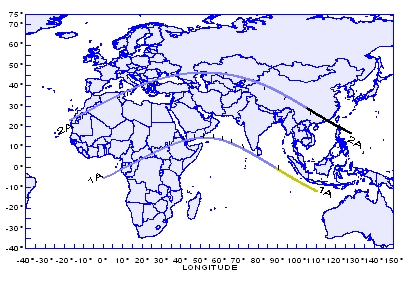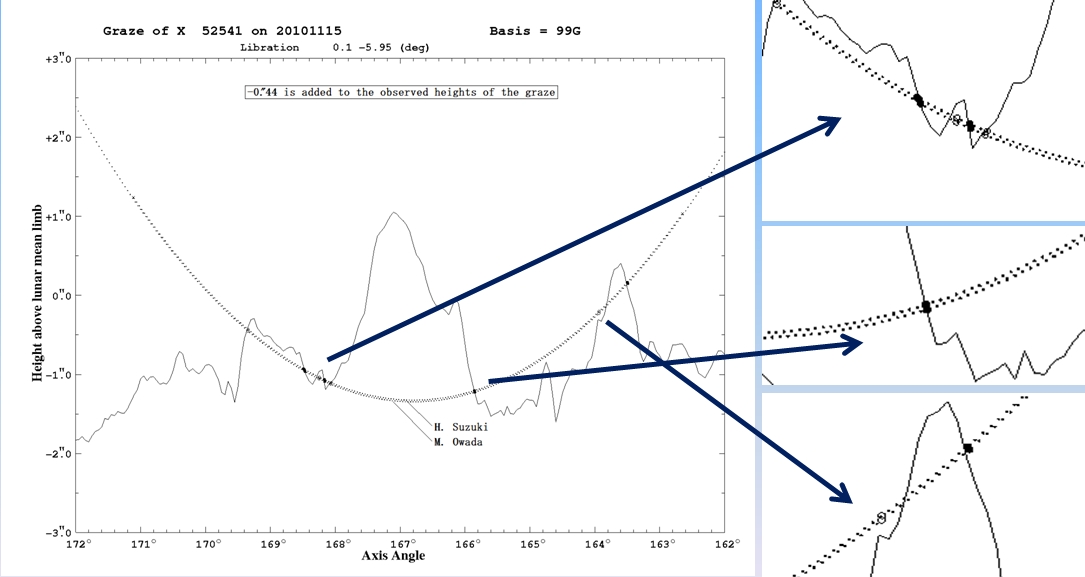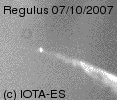
Grazing Occultations of Stars by the Moon
Among all occultation phenomena in the sky grazing occultations of stars by the moon have a very unique character. The observation of these spectacular events does not require any large and expensive telescope, but rather a small and transportable instrument like many amateur astronomers own one. As the moon circles the earth monthly it occults stars that lie in the lunar path. At that instant the star casts an invisible shadow of the moon on the earth’s surface. Anyone standing at the edges of this shadow can see the lunar surface scratch along the star, covering it behind higher terrain features often several times at each graze and revealing it in between in depressed areas.

Being in the right location at a specified time the glance through the telescope’s eyepiece easily lets you find the star to be occulted next to the moon. As the moon gets closer to the star the lunar brightness sometimes makes it more difficult to clearly see the star depending on the lunar phase and thus of the sunlit percentage of the moon’s surface. When the distance between the lunar structures and the star is really small a fascinating phenomenon occurs which cannot be seen in any other astronomical observation: the motion of the moon around the earth becomes directly visible: The lunar landscape slowly but noticeably crawls along the star. Since the moon has no atmosphere the disappearances and reappearances of the star in the terrain structures happen so unexpectedly that even trained visual observers often don’t react for a few tenths of a second. The beauty of these events is famous.
The Scientific Purpose
Through the observation and timing of grazing occultations especially amateur astronomers can contribute to science. The scientific value itself changed over the decades. First systematic observations reach back to the end of the 1950s and allowed both the measuring of lunar limb terrain features as well as the detection of erroneous stellar positions. Back then even many zodiacal stars did not have well measured positions or proper motions. The lunar limb itself during a grazing occultation is best captured by a group of observers standing on a line more or less perpendicular to the graze path and thus in different depths referred to the limb structures. As the lunar shadow sweeps over the earth the limb profile can be assembled through the different lengths of timings of dis- and reappearances of the star. Due to lacking precision in the past concerning the lunar limb heights missed observations were not rare in cases a depressed terrain left the star fully unocculted.
A photographic catalog by C. B. Watts, USA, published in 1963 gave lunar profile height values in all libration ranges and helped in improving the prediction precision. It was not very precise though and also left blank a big limb area that never is hit by sunlight (Cassini-region).In the beginning of the 1990s the Hipparcos catalog improved the precision of stellar positions and proper motions considerably allowing to set out grazing occultation observations more on improving the knowledge of the lunar limb details. That way the photographic Watts data could be corrected more and more and the empty Cassini-regions became known event by event. Latest spacecraft laser ranging as by the Japanese Kaguya-mission launched in 2007 and the NASA Lunar Reconnaissance Orbiter mission (LRO) in 2009 resulted in lunar surface structures with a precision of 200 meters down to 5 meters.
But until today the reductions of earthbound observations of grazing occultations contribute to further precision improvement of both lunar terrain features and knowledge of the occulted stars. The technical demands for earthbound measurements have increased though to yield the needed precision concerning both positioning and timing necessities for the observer (see further down: Needed Equipment). Since the predictions are very precise nowadays it is possible to reveal many more profile details by a narrow positioning of the observing stations. Still yet unknown double and multiple star systems are discovered and/or can be investigated closely through their occultations by the moon. If timing is possible with high resolution there is a high professional interest to learn more about these systems and to measure stellar diameters

Reductions
of grazing occultations also still reveal errors in the stellar
proper motions as published in the Hipparcos catalog. Reductions
so far even suggest an overall rotational error of the Hipparcos
reference frame. These errors are expected to be solved through
the upcoming Gaia mission of the European Space Agency when 1
billion stars will be newly measured with a precision down to 1
micro second of arc.
A detailed knowledge of the structures of the lunar limb allows the precise measurement of the diameter of the sun during total or annular solar eclipses. For these events observing positions at the northern as well as the southern edge of the moon’s umbra must be selected by several observers to see the moon ‘graze’ the solar limb. At closest contact the beautiful Baily’s Beads phenomenon shows those parts of the solar photosphere glaring through the smallest valleys at the lunar limb. These allow to find the mean lunar limb and thus the baseline between the northern and the southern mean limb as the precise diameter of the lunar shadow. The solar radius deducted from this so far showed variations within a range of some 400 km. More research is needed here to achieve more evidence that the sun is really pulsating to a small extent.
Page 2 (Circumstances at the lunar limb; Observing precision requirements)
Page 3 (Observing techniques - Needed equipment)
Grazing lunar occultation of Regulus, recorded on the 7th of October 2007
